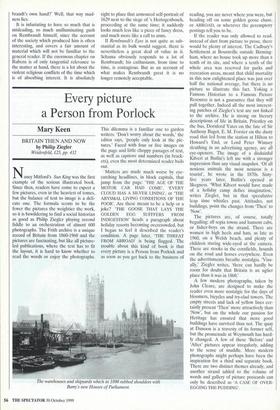Every picture a Person from Porlock
Mary Keen
BRITAIN THEN AND NOW by Philip Ziegler Weidenfeld, £25, pp. 432
Nancy Mitford's Sun King was the first example of the serious illustrated book. Since then, readers have come to expect a few pictures, even in the heaviest of tomes, but the balance of text to image is a deli- cate one. The formula seems to be the fewer the pictures the weightier the work, so it is bewildering to find a social historian as good as Philip Ziegler playing second fiddle to an orchestration of almost 600 photographs. The Frith archive is a unique record of Britain from 1860-1960 and the pictures are fascinating, but like all picture- led publications, where the text has to fit the layout, it is hard to know whether to read the words or enjoy the photographs.
This dilemma is a familiar one to garden writers. 'Don't worry about the words,' the editor says, 'people only look at the pic- tures.' Faced with four or five images on the page and little choppy passages of text, as well as captions and numbers (in brack- ets), even the most determined reader bails out.
Matters are made much worse by eye- catching headlines, in block capitals, that jump from the page: 'THE AGE OF THE MOTOR CAR HAD COME', 'EVERY CLOUD HAS A SILVER LINING', or 'THE ABYSMAL LIVING CONDITIONS OF THE POOR'. Are these meant to be a help or a joke? 'THE GOOSE THAT LAYS THE GOLDEN EGG SUFFFERS FROM INDIGESTION' heads a paragraph about holiday resorts becoming overcrowded, but I began to feel it described the reader's condition. A page later, 'THE THREAT FROM ABROAD' is being flagged. The trouble about this kind of book is that every picture is a Person from Porlock and as soon as you get back to the business of
!he warehouses and shipyards which in 1890 rubbed shoulders with Bany's new Houses of Parliament.
reading, you are never where you were, but heading off on some golden goose chase, or ABROAD, or wherever the peremptory postings tell you to be.
If the reader was only allowed to read, instead of dart from picture to prose, there would be plenty of interest. The Cadbury's Settlement at Bournville outside Birming- ham, where no house took up more than a tenth of its site, and where a tenth of the whole area was reserved for parks and recreation areas, meant that child mortality in this new enlightened place was just over half the national average, but there is no picture to illustrate this fact. Yoking a Famous Historian to a Famous Picture Resource is not a guarantee that they will pull together. Indeed all the most interest- ing patches of Ziegler's text are not linked to the archive. He is strong on literary descriptions of life in Britain. Priestley on the bus, Dornford Yates on the fate of Sir Anthony Bagot, E. M. Forster on the dusty road that led from the station at Hilton to Howard's End, or Lord Peter Wimsey sleuthing in an advertising agency, are all eye-openers. The image of a disdainful Kilvert at Butlin's left me with a stronger impression than any visual snapshot. 'Of all noxious animals the most noxious is a tourist', he wrote in the 1870s. Sixty- five years later, Butlin's opened at Skegness. 'What Kilvert would have made of a holiday camp defies imagination,' writes Ziegler, but in that speculative leap time whistles past. Attitudes, not buildings, point the changes from 'Then' to 'Now'.
The pictures are, of course, totally beguiling: all sepia towns and hansom cabs, or fisher-boys on the strand. There are women in high heels and hats, as late as 1960, on a Welsh beach, and plenty of children staring wide-eyed at the camera. There are stooks in the cornfields, hounds on the road and horses everywhere. Even the advertisments breathe nostalgia. 'Visu- ally,' Ziegler writes, 'there can hardly be room for doubt that Britain is an uglier place than it was in 1860.'
A few modern photographs, taken by John Cleare, are designed to make the reader even more nostalgic for the days of bloomers, bicycles and ivy-clad towers. The empty streets and lack of yellow lines cer- tainly present 'Then' more attractively than 'Now', but on the whole our passion for Heritage has ensured that more good buildings have survived than not. The quay at Dunoon is a travesty of its former self, but the promenade at Weymouth has hard- ly changed. A few of these 'Before' and 'After' pictures appear irregularly, adding to the sense of muddle. More modern photographs might perhaps have been the inspiration for a third and separate book. There are two distinct themes already, and another strand added to the volume of words and gallery of picture postcards can only be described as 'A CASE OF OVER- EGGING THE PUDDING'.


























































































 Previous page
Previous page